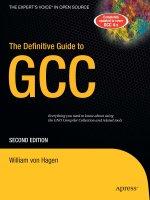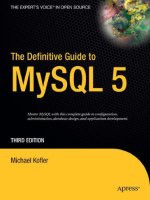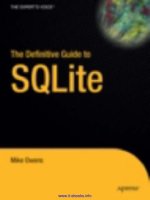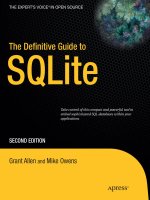asking questions the definitive guide to questionnaire design—for market research, political polls, and social and health questionnaires
Bạn đang xem bản rút gọn của tài liệu. Xem và tải ngay bản đầy đủ của tài liệu tại đây (4.52 MB, 446 trang )
TeAM
YYePG
Digitally signed by TeAM YYePG
DN: cn=TeAM YYePG, c=US,
o=TeAM YYePG, ou=TeAM
YYePG, email=
Reason: I attest to the accuracy
and integrity of this document
Date: 2005.02.05 00:26:34
+08'00'
Asking
Questions
The Definitive Guide to
Questionnaire Design—
For Market Research, Political Polls,
and Social and Health Questionnaires,
Revised Edition
fm.Bradburn 3/12/04 11:28 AM Page v
fm.Bradburn 3/12/04 11:28 AM Page i
fm.Bradburn 3/12/04 11:28 AM Page ii
Asking Questions
fm.Bradburn 3/12/04 11:28 AM Page iii
Norman M. Bradburn
Seymour Sudman
Brian Wansink
fm.Bradburn 3/12/04 11:28 AM Page iv
Asking
Questions
The Definitive Guide to
Questionnaire Design—
For Market Research, Political Polls,
and Social and Health Questionnaires,
Revised Edition
fm.Bradburn 3/12/04 11:28 AM Page v
Copyright © 2004 by John Wiley & Sons, Inc. All rights reserved.
Published by Jossey-Bass
A Wiley Imprint
989 Market Street, San Francisco, CA 94103-1741 www.josseybass.com
No part of this publication may be reproduced, stored in a retrieval system, or transmitted
in any form or by any means, electronic, mechanical, photocopying, recording, scanning,
or otherwise, except as permitted under Section 107 or 108 of the 1976 United States
Copyright Act, without either the prior written permission of the Publisher, or authorization
through payment of the appropriate per-copy fee to the Copyright Clearance Center, Inc.,
222 Rosewood Drive, Danvers, MA 01923, 978-750-8400, fax 978-646-8600, or on the web
Permissions Department, John Wiley & Sons, Inc., 111 River Street, Hoboken, NJ 07030,
201-748-6011, fax 201-748-6008, e-mail:
Jossey-Bass books and products are available through most bookstores. To contact
Jossey-Bass directly call our Customer Care Department within the U.S. at 800-956-7739,
outside the U.S. at 317-572-3986, or fax 317-572-4002.
Jossey-Bass also publishes its books in a variety of electronic formats. Some content that
appears in print may not be available in electronic books.
Library of Congress Cataloging-in-Publication Data
Bradburn, Norman M.
Asking questions : the definitive guide to questionnaire design—for
market research, political polls, and social and health questionnaires /
Norman M. Bradburn, Brian Wansink, Seymour Sudman.—Rev. ed.
p. cm.
Earlier ed. by Sudman and Bradburn with Sudman named first.
Includes bibliographical references (p. ) and index.
ISBN 0-7879-7088-3 (alk. paper)
1. Social sciences—Research. 2. Questionnaires. I. Wansink, Brian.
II. Sudman, Seymour. III. Title.
H62.B63 2004
300'.72'3—dc22 2004001683
Printed in the United States of America
FIRST EDITION
PB Printing 10987654321
fm.Bradburn 3/12/04 11:28 AM Page vi
at www.copyright.com. Requests to the Publisher for permission should be addressed to the
Contents
Preface and Acknowledgments xi
The Authors xv
Part I. Strategies for Asking Questions
1. The Social Context of Question Asking 3
Part II. Tactics for Asking Questions
2. Asking Nonthreatening Questions About Behavior 35
3. Asking Threatening Questions About Behavior 79
4. Asking Questions About Attitudes and
Behavioral Intentions 117
5. Asking and Recording Open-Ended and
Closed-Ended Questions 151
6. Asking Questions that Measure Knowledge 179
7. Asking Questions that Evaluate Performance 213
8. Asking Psychographic Questions 243
9. Asking Standard Demographic Questions 261
Part III. Drafting and Crafting the Questionnaire
10. Organizing and Designing Questionnaires 283
11. Questionnaires from Start to Finish 315
vii
fm.Bradburn 3/12/04 11:28 AM Page vii
12. Asking Questions FAQs 323
Bibliography and Recommended Readings 335
Glossary 347
Index 367
Appendix A: List of Academic and Not-for-Profit
Survey Research Organizations 375
Appendix B: Illinois Liquor Control Commission:
College Student Survey 411
Appendix C: Faculty Retention Survey 417
Appendix D: Kinko’s: Open-ended Service
Satisfaction Survey 425
viii C
ONTENTS
fm.Bradburn 3/12/04 11:28 AM Page viii
This book is dedicated to the memory of our colleague
and coauthor Seymour Sudman who died tragically
while we were in the midst of writing this book.
His spirit and wisdom have continued to inspire
us as we brought this manuscript to press.
He lives on in this book.
fm.Bradburn 3/12/04 11:28 AM Page ix
fm.Bradburn 3/12/04 11:28 AM Page x
xi
Preface
This book is a revised and updated edition of Asking Questions: A
Practical Guide to Questionnaire Design, first published in 1982. It
focuses on the type of question asking that social science researchers
and market researchers use in structured questionnaires or inter-
views. Many of the principles of effective formalized questioning we
focus on in this book are useful in other contexts. They are useful
in informal or semistructured interviews, in administering printed
questionnaires in testing rooms, and in experimental studies involv-
ing participant evaluations or responses.
We intend this book to be a useful “handbook” for sociologists,
psychologists, political scientists, evaluation researchers, social
workers, sensory scientists, marketing and advertising researchers,
and for many others who have occasion to obtain systematic infor-
mation from clients, customers, or employees.
In the past two decades, two major changes in the practice of
survey research prompted us to produce a revised edition. First,
there has been a revolution in research on question asking brought
about by the application of cognitive psychology to the study of
questionnaire design. We now have a conceptual framework for
understanding the question-answering process and the causes of the
various response effects that have been observed since the early
days of social scientific surveys. This work has helped move ques-
tionnaire construction from an art to a science.
Second, there has been a technological revolution in the way
computers can be used to support the survey process. Computer-
assisted survey information collection (
CASIC) refers to a variety
intromatter.Bradburn 3/10/04 3:35 PM Page xi
xii P
REFACE
of specialized programs used to support survey data collection—for
example, CAPI (computer-assisted personal interviewing) or CATI
(computer-assisted telephone interviewing), to name the most
common forms of CASIC. The greater use of computer technology
at every stage of data collection in surveys has made many of the
suggestions in our earlier edition obsolete and necessitated a thor-
ough reworking of discussion that was predicated on traditional
paper-and-pencil questionnaires. We are also beginning an era of
Web-based surveys. Although there is still much to learn about this
new method of conducting surveys, we have tried to incorporate
what we know at this time into our discussions where relevant.
We have tried to make the book self-contained by including
major references. Some readers, however, may wish to refer to our
earlier books, Response Effects in Surveys: A Review and Synthesis
(Sudman and Bradburn, 1974); Improving Interview Method and
Questionnaire Design: Response Effects to Threatening Questions in
Survey Research (Bradburn, Sudman, and Associates, 1979); Think-
ing About Answers (Sudman, Bradburn, and Schwarz, 1996); and
Consumer Panels, (Sudman and Wansink, 2002), for more detailed
discussion of the empirical data that support our recommendations.
This book is specifically concerned with questionnaire con-
struction—not with all aspects of survey design and administration.
Although we stress the careful formulation of the research problems
before a questionnaire is designed, we do not tell you how to select
and formulate important research problems. To do so requires a
solid knowledge of your field—knowledge obtained through study
and review of earlier research, as well as hard thinking and creativ-
ity. Once the research problem is formulated, however, this book
can help you ask the right questions.
The book is divided into three parts. In Part I we discuss the
social context of question asking. We present our central thesis,
namely that questions must be precisely worded if responses to a
survey are to be accurate; we outline a conceptual framework for
understanding the survey interview and present examples to illus-
intromatter.Bradburn 3/10/04 3:35 PM Page xii
trate some of the subtleties of language and contexts that can cause
problems. We also discuss some of the ethical principles important
to survey researchers—the right to privacy, informed consent, and
confidentiality of data.
Part II is devoted to tactics for asking questions. In Chapters
Two through Nine we consider the major issues in formulating
questions on different topics, such as the differences between re-
quirements for questions about behavior and for questions about
attitudes. We also consider how to ask questions dealing with
knowledge and special issues in designing questions that evaluate
performance, measure subjective characteristics, and measure
demographic characteristics.
In Part III we turn from the discussion of the formulation of
questions about specific kinds of topics to issues involved in craft-
ing the entire questionnaire. We discuss how to organize a ques-
tionnaire and the special requirements of different modes of data
collection, such as personal interviewing, telephone interviewing,
self-administration, and electronic surveying. We end with a set of
frequently asked questions and our answers.
Throughout the book we use terms that are well understood by
survey research specialists but that may be new to some of our read-
ers. We have therefore provided a glossary of commonly used sur-
vey research terms. Many of the terms found in the Glossary are
also discussed more fully in the text. In addition, we have included
a list of academic and not-for-profit survey research organizations in
Appendix A.
The chapters in Part II are introduced with a checklist of items
to consider. The checklists are intended as initial guides to the
major points made and as subsequent references for points to keep
in mind during the actual preparation of a questionnaire.
Readers new to designing surveys should read sequentially from
beginning to end. Experienced researchers and those with specific
questionnaire issues will turn to appropriate chapters as needed. All
readers should find our detailed index of use.
P
REFACE
xiii
intromatter.Bradburn 3/10/04 3:35 PM Page xiii
In this book we have distilled a vast amount of methodological
research on question asking to give practical advice informed by
many years of experience in a wide variety of survey research areas.
But much is still not known. We caution readers seeking advice on
how to write the perfect questionnaire that perfection cannot be
guaranteed. For readers who wish to do additional research in ques-
tionnaire design, much interesting work remains to be done.
Acknowledgments
While we were in the process of writing this new edition, Seymour
Sudman died tragically. His vast knowledge of the research litera-
ture, deep experience, and wise judgment continue to enrich this
volume. We miss him greatly.
This edition builds on its predecessor and all those who con-
tributed to it. We are indebted to many colleagues at the Survey
Research Laboratory (
SRL), University of Illinois, and at the
National Opinion Research Center (NORC), University of
Chicago. These colleagues include Herbert Jackson, who compiled
the material for Chapter Twelve, and Matthew Cheney, Sarah Jo
Brenner, and Martin Kator, who helped in manuscript preparation
by compiling and summarizing recently published findings in the
area of survey design.
At Jossey-Bass, Seth Schwartz and Justin Frahm: We are grate-
ful for their patience with the sometimes distracted authors and
for their inventive solutions to the inevitable challenges that
arose in turning a manuscript into an aesthetically pleasing book.
Readers, as do we, owe them all a deep debt of gratitude.
Norman Bradburn
Arlington, Virginia
Brian Wansink
Urbana, Illinois
August 2003
xiv P
REFACE
intromatter.Bradburn 3/10/04 3:35 PM Page xiv
The Authors
Norman M. Bradburn (Ph.D. Harvard University, 1960) is the Mar-
garet and Tiffany Blake Distinguished Service Professor emeritus in
the Department of Psychology and the Harris Graduate School of
Public Policy Studies at the University of Chicago. He has written
widely, often with Seymour Sudman, on topics in survey method-
ology. He was a pioneer in the application of cognitive psychology
to the design of survey questionnaires. For a number of years, he was
the director of the National Opinion Research Center at the Uni-
versity of Chicago. He is currently the assistant director for social,
behavioral, and economic sciences at the National Science Foun-
dation.
Seymour Sudman (Ph.D. University of Chicago, 1962) was the
Walter H. Stellner Distinguished Professor of Marketing at the
University of Illinois (Urbana-Champaign) from 1968 until his
death in 2000. Through a lifetime of active research, he con-
tributed immeasurably to the area of survey design, sampling, and
methodology. He was actively involved in providing guidance to
the U.S. Census Bureau, and he served as deputy director and
research professor of the Survey Research Laboratory at the Uni-
versity of Illinois.
Brian Wansink (Ph.D. Stanford University, 1990) is the Julian Simon
Research Scholar and professor of marketing, of nutritional science,
of advertising, and of agricultural and consumer economics at the
xv
intromatter.Bradburn 3/10/04 3:35 PM Page xv
University of Illinois (Urbana-Champaign) and is an adjunct
research professor at Cornell University and at Wageningen Uni-
versity in the Netherlands. He directs the Food and Brand Lab,
which focuses on psychology related to food choice and consump-
tion (www.FoodPsychology. com). Prior to moving to Illinois,
he was a marketing professor at Dartmouth College and at the
Wharton School at the University of Pennsylvania. He coauthored
Consumer Panels with Seymour Sudman.
xvi T
HE
A
UTHORS
intromatter.Bradburn 3/10/04 3:35 PM Page xvi
Asking Questions
intromatter.Bradburn 3/10/04 3:35 PM Page xvii
intromatter.Bradburn 3/10/04 3:35 PM Page xviii
Part One
Strategies for
Asking Questions
C01.Bradburn 3/10/04 3:31 PM Page 1
C01.Bradburn 3/10/04 3:31 PM Page 2
Chapter One
The Social Context
of Question Asking
The precise wording of questions plays a vital role in determining
the answers given by respondents. This fact is not appreciated as
fully as it should be, even in ordinary conversation. For example,
a colleague mentioned that he needed to pick out granite for a
kitchen countertop. The only day he could make the trip was the
Saturday before Labor Day. Although he called on Friday to make
certain the store was open, he arrived at the store on Saturday only
to find a sign on the door that said “Closed Labor Day Weekend.”
When asked if he remembered what question he had asked the
clerk at the store, he said, “I asked him what hours he was open on
Saturday, and he replied ‘Nine to five.’”
This story illustrates the basic challenge for those who engage
in the business of asking questions. It illustrates not only the impor-
tance of the golden rule for asking questions—Ask what you want
to know, not something else—but also, more important, the ambi-
guities of language and the powerful force of context in interpret-
ing the meaning of questions and answers. Our colleague had
unwittingly asked a perfectly ambiguous question. Did the question
refer to Saturdays in general or the next Saturday specifically? The
clerk obviously interpreted the question as referring to Saturdays in
general. Our colleague meant the next Saturday and did not think
his question could mean anything else until he arrived at the store
and found it closed.
In everyday life, these types of miscommunications happen all
the time. Most of the time they are corrected by further conversa-
tion or by direct questions that clarify their meaning. Sometimes
3
C01.Bradburn 3/10/04 3:31 PM Page 3
they only get corrected when expected behavior does not occur, as
was the case when the store turned out to be closed. But the stylized
form of question asking used in surveys does not often provide feed-
back about ambiguities or miscommunications. We must depend on
pretesting to weed out ambiguities and to help reformulate ques-
tions as clearly as possible—to ask about what we want to know, not
something else.
The thesis of this book is that question wording is a crucial ele-
ment in surveys. The importance of the precise ordering of words in
a question can be illustrated by another example.
Two priests, a Dominican and a Jesuit, are discussing whether it is a
sin to smoke and pray at the same time. After failing to reach a con-
clusion, each goes off to consult his respective superior. The next
week they meet again. The Dominican says, “Well, what did your
superior say?”
The Jesuit responds, “He said it was all right.”
“That’s funny,” the Dominican replies. “My superior said it was
a sin.”
The Jesuit says, “What did you ask him?”
The Dominican replies, “I asked him if it was all right to smoke
while praying.”
“Oh,” says the Jesuit. “I asked my superior if it was all right to pray
while smoking.”
Small Wording Changes that Made Big Differences
The fact that seemingly small changes in wording can cause large
differences in responses has been well known to survey practition-
ers since the early days of surveys. Yet, typically, formulating the
questionnaire is thought to be the easiest part of survey research and
often receives too little effort. Because no codified rules for question
asking exist, it might appear that few, if any, basic principles exist to
differentiate good from bad questions. We believe, however, that
many such principles do exist. This book provides principles that
4 A
SKING
Q
UESTIONS
C01.Bradburn 3/10/04 3:31 PM Page 4
novices and experienced practitioners can use to ask better ques-
tions. In addition, throughout the book we present examples of
both good and bad questions to illustrate that question wording and
the question’s social context make a difference.
Loaded Words Produce Loaded Results
Suppose a person wanted to know whether workers believed they
were fairly compensated for their work. Asking “Are you fairly com-
pensated for your work?” is likely to elicit a very different answer
than asking “Does your employer or his representative resort to
trickery in order to defraud you of part of your earnings?” One
would not be surprised to find that an advocate for improving the
situation of workers asked the second question. Clearly the uses of
words like “trickery” and “defraud” signal that the author of the
question does not have a high opinion of employers. Indeed, this
was a question asked by Karl Marx on an early survey of workers.
Questionnaires from lobbying groups are often perceived to be
biased. A questionnaire received by one of the authors contained
the following question: “The so-called ‘targeted tax cuts’ are a maze
of special interest credits for narrow, favored groups. Experts agree
the complex, loophole-ridden tax code makes it easy for Big Gov-
ernment liberals to raise taxes without the people even realizing
it. Do you feel a simpler tax system—such as a single flat rate or a
national sales tax with no income tax—would make it easier for you
to tell when politicians try to raise your taxes?”
Even an inexperienced researcher can see that this question is
heavily loaded with emotionally charged words, such as “so-called,”
“loophole-ridden,” and “Big Government liberal.” The authors of
this questionnaire are clearly interested in obtaining responses that
support their position. Although the example here is extreme, it
does illustrate how a questionnaire writer can consciously or uncon-
sciously word a question to obtain a desired answer. Perhaps not sur-
prisingly, the questionnaire was accompanied by a request for a
contribution to help defray the cost of compiling and publicizing
T
HE
S
OCIAL
C
ONTEXT OF
Q
UESTION
A
SKING
5
C01.Bradburn 3/10/04 3:31 PM Page 5









